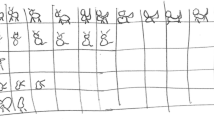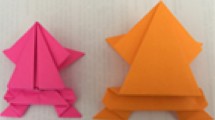Abstract
An educational priority of many nations is to enhance mathematical learning in early childhood. One area in need of special attention is that of statistics. This paper argues for a renewed focus on statistical reasoning in the beginning school years, with opportunities for children to engage in data modelling activities. Such modelling involves investigations of meaningful phenomena, deciding what is worthy of attention (identifying complex attributes), and then progressing to organising, structuring, visualising, and representing data. Results reported here are derived from the first year of a three-year longitudinal study in which three classes of first-grade children and their teachers engaged in activities requiring the creation of data models. The theme of “Looking after our Environment,” a component of the children’s science curriculum at the time, provided the context for the activities. Findings include children’s abilities to focus their attention on qualities of items rather than the items themselves in identifying attributes, switch their attention from one item feature to another, and create a broad range of models in organising, structuring, and representing their data. Children’s development of meta-representational knowledge facilitated their choice and nature of data representations.
Similar content being viewed by others
References
Australian Labor Party. (2009).An Education Revolution for Australia’s Future. Retrieved November 4, 2009 from http://www.alp.org.au/platform/chapter_05.php.
Australian Labor Party. (2007).New Directions for our Schools: A National Action Plan on Literacy and Numeracy. Retrieved from parlinfo.aph.gov.au/parlinfo/download/library/partypol/2RP06/2rp062.pdf
Australian Association of Mathematics Teachers & Early Childhood Australia. (2006).Position paper on early childhood mathematics. Retrieved October 10, 2009 from http://www.aamt.edu.au
Australian Curriculum, Assessment and Reporting Authority (ACARA).National Assessment Program-Literacy and Numeracy. Retrieved August 3, 2010, from www.naplan.edu.au.
Casey, B. M., Andrews, N., Schindler, H., Kersh, J. E., & Alexandra, S. (2008). The development of spatial skills through interventions involving block building activities.Cognition and Instruction, 26(3), 269–309.
Casey, B. M., Kersh, J. E., & Mercer Young, J. (2004). Storytelling sagas: An effective medium for teaching early childhood mathematics.Early Childhood Research Quarterly: Special Issue on Mathematics and Science, 19(1), 167–172.
Cengiz, N., & Grant, T. J. (2009). Children generate their own representations.Teaching Children Mathematics, 15(7), 438–444.
Clarke, B., Clarke, D., & Cheesman, J. (2006). The mathematical knowledge and understanding young children bring to school.Mathematics Education Research Journal, 18(1), 78–103.
Curriculum Corporation. (2009).Statements of Learning for Mathematics (2008) and Statements of Learning for Science (2008). Retrieved August 2, 2010, from http://www.curriculum.edu.au/ccite/default.asp?id+17706
Cursio, F. R., & Folkson, S. (1996). Exploring data: Kindergarten children do it their way.Teaching Children Mathematics, 2(6), 382–385.
diSessa, A., Hammer, D., Sherin, B., & Kolpakowski, T. (1991). Inventing graphing: Metarepresentational expertise in children.Journal of Mathematical Behavior, 10(1), 117–160.
Doerr, H. M., & Tripp, J. S. (1999). Understanding how students develop mathematical models.Mathematical Thinking and Learning, 1(3), 231–254.
English, L. D. (2003a). Mathematical modelling with young learners. In S. J. Lamon, W. A. Parker, & S. K. Houston (Eds.),Mathematical modelling: A way of life (pp. 3–18). Chichester, UK:Horwood.
English, L. D. (2003b). Reconciling theory, research, and practice: A models and modelling perspective.Educational Studies in Mathematics, 54(2/3), 225–248.
English, L. D. (2008). Introducing complex systems into the mathematics curriculum.Teaching Children Mathematics, 15(1), 38–47.
English, L. D., & Halford, G. S. (1995).Mathematics education: Models and processes. Mahwah, NJ:Lawrence Erlbaum.
English, L. D., & Watters, J. J. (2005). Mathematical modelling in third-grade classrooms.Mathematics Education Research Journal, 16(3), 59–80.
Franklin, C. A., & Garfield, J. (2006). The GAISE project: Developing statistics education guidelines for grades pre-K-12 and college courses. In G. Burrill & P. Elliott (Eds.),Thinking and reasoning with data and chance (68th Yearbook, pp. 345–376). Reston, VA:National Council of Teachers of Mathematics.
Gravemeijer, K. (1999). How emergent models may foster the construction of formal mathematics.Mathematical Thinking and Learning, 1(2), 155–177.
Greer, B. (1997). Modeling reality in mathematics classroom: The case of word problems.Learning and Instruction, 7(4), 293–307.
Greer, B., Verschaffel, L., & Mukhopadhyay, S. (2007). Modelling for life: Mathematics and children’s experience. In W. Blum, W. Henn, & M. Niss (Eds.),Applications and modelling in mathematics education (ICMI Study 14, pp. 89–98). Dordrecht:Kluwer.
Hamilton, E. (2007). What changes are needed in the kind of problem solving situations where mathematical thinking is needed beyond school? In R. Lesh, E. Hamilton, & J. Kaput (Eds.),Foundations for the future in mathematics education (pp. 1–6). Mahwah, NJ:Lawrence Erlbaum.
Hanner, S., James. E., & Rohlfing, M. (2002). Classification models across grades. In R. Lehrer, & L. Schauble (Eds.),Investigating real data in the classroom (pp. 99–117). New York:Teachers College Press.
Hurst, B. (2008).Look after your planet. London:Puffin.
Hutchison, L., Ellsworth, J., & Yovich, S. (2000). Third-grade students investigate and represent data.Early Childhood Education Journal, 27(4), 213–218.
Langrall, C., Nisbet, S., Mooney, E., & Jones, G. (2008). Elementary students’ access to powerful mathematical ideas. In L. D. English (Ed.),Handbook of international research in mathematics education (2nd ed.) (pp. 109–135). New York:Routledge.
Leavy, A. (2007). An examination of the role of statistical investigation in supporting the development of young children’s statistical reasoning. In O. Saracho & B. Spodek (Eds.),Contemporary perspectives on mathematics in early childhood education (pp. 215–232). Charlotte, NC:Information Age Publishing
Lehrer, R., & Lesh, R. (2003) Mathematical Learning. In W. Reynolds & G. Miller (Eds.)Comprehensive handbook of psychology (Vol. 7, pp. 357–390). New York:John Wiley.
Lehrer, R., & Romberg, T. (1996). Exploring children’s data modeling.Cognition and Instruction, 14(1), 69–108.
Lehrer, R., & Schauble, L. (2000). Inventing data structures for representational purposes: Elementary grade students’ classification models.Mathematical Thinking and Learning, 2(1/2), 51–74.
Lehrer, R., & Schauble, L. (2003). Origins and evolution of model-based reasoning in mathematics and science. In R. A. Lesh, & H. M. Doerr (Eds.).Beyond constructivism: Models and modeling perspectives on mathematics problem solving, learning, and teaching (pp. 59–70). Mahwah, NJ:Lawrence Erlbaum.
Lehrer, R., & Schauble, L. (2005). Developing modeling and argument in the elementary grades. In T. Romberg, T. Carpenter & F. Dremock (Eds.),Understanding mathematics and science matters (pp. 29–53). Mahwah, NJ:Lawrence Erlbaum.
Lehrer, R., & Schauble, L. (2006). Cultivating model-based reasoning in science education. In R. K. Sawyer (Ed.),The Cambridge handbook of the learning sciences (pp. 371–386). New York:Cambridge University Press.
Lehrer, R., & Schauble, L. (2007). Contrasting emerging conceptions of distribution in contexts of error and natural variation. In M. C. Lovett & P. Shah (Eds.),Thinking with data (pp. 149–176). New York:Taylor & Francis.
Lesh, R., & Doerr, H. (2003). Foundation of a models and modeling perspective on mathematics teaching and learning. In R. A. Lesh & H. Doerr (Eds.),Beyond constructivism: A models and modeling perspective on mathematics teaching, learning, and problem solving (pp. 9–34). Mahwah, NJ:Lawrence Erlbaum.
Lesh, R. & English, L. D. (2005). Trends in the evolution of models & modeling perspectives on mathematical learning and problem solving.ZDM-The International Journal on Mathematics Education, 37(6), 487–489.
Lesh, R. A., & Kelly, A. E. (2000). Multi-tiered teaching experiments. In R. A. Lesh & A. Kelly (Eds.),Handbook of research design in mathematics and science education (pp. 197–230). Hillsdale, NJ:Lawrence Erlbaum.
Lesh, R., & Lehrer, R. (2000). Iterative refinement cycles for videotape analyses of conceptual change. In R. Lesh & A. Kelly (Eds.),Research design in mathematics and science education (pp. 665–708). Hillsdale, NJ:Lawrence Erlbaum.
Lesh, R., & Zawojewski, J. S. (2007). Problem solving and modeling. In F. Lester (Ed.),The second handbook of research on mathematics teaching and learning (pp. 763–804). Charlotte, NC:Information Age Publishing.
Olson, D. R. (1994).The world on paper. Cambridge, UK:Cambridge University Press.
Perry, B., & Dockett, S. (2008). Young children’s access to powerful mathematical ideas. In L. D. English (Ed.),Handbook of international research in mathematics education (2nd ed.) (pp. 75–108). New York:Routledge.
National Council of Teachers of Mathematics. (2006).Curriculum focal points. Retrieved October 20, 2008, from http://www.nctm.org/standards/content.aspx?id=270.
Romberg, T. A., Carpenter, T. P., & Kwako, J. (2005). Standards-based reform and teaching for understanding. In T. A. Romberg, T. P. Carpenter, & F. Dremock (Eds.),Understanding mathematics and science matters (pp. 3–26). Mahwah, NJ:Lawrence Erlbaum.
Russell, S. J. (1991). Counting noses and scary things: Children construct their ideas about data. In D. Vere-Jones (Ed.),Proceedings of the Third International Conference on the Teaching of Statistics (pp. 158–164). University of Otago:Dunedin, NZ.
Stillman, G., Brown, J., & Galbraith, P. (2008). Research into the teaching and learning of applications and modelling in Australia. In H. Forgasz, A. Barkatsas, A. Bishop, B. Clarke, S. Keast, W. Seah, & P. Sullivan (Eds.),Research in mathematics education in Australasia, 2004–2007 (pp. 141–164). Rotterdam, The Netherlands:Sense Publishers.
Strauss, A., & Corbin, J. (1990).Basics of qualitative research: Ground theory procedures and techniques. CA:Sage.
Van den Heuvel-Panhuzen, M. (2003). The didactical use of models in realistic mathematics education: An example from a longitudinal trajectory on percentage.Educational Studies in Mathematics, 54(2/3), 9–35.
Watson, J. (2006).Statistical literacy at school: Growth and goals. Mahwah, NJ:Lawrence Erlbaum.
Zawojewski, J. (2010). Problem solving versus modeling. In R. Lesh, P. Galbraith, C. R. Haines, & A. Hurford (Eds.),Modeling students’ mathematical modeling competencies: ICTMA 13 (pp. 237–244). New York:Springer.
Author information
Authors and Affiliations
Rights and permissions
About this article
Cite this article
English, L.D. Young children’s early modelling with data. Math Ed Res J 22, 24–47 (2010). https://doi.org/10.1007/BF03217564
Issue Date:
DOI: https://doi.org/10.1007/BF03217564




